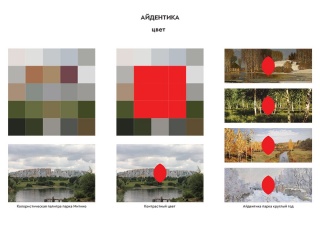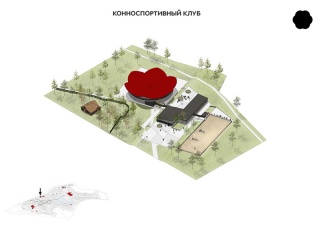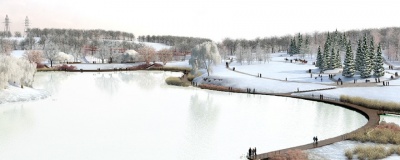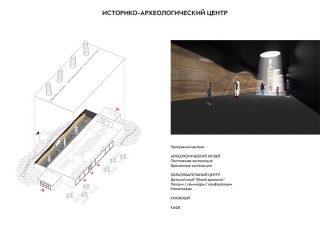Red was chosen as an identifying trademark of the park for its inherent connection to the city of Moscow, as well as its strong presence amid the seasonally changing landscape.
A red leaf found on our initial site visit triggered the creation of a flexible system of architectural elements. Simple and delicate, the leaf became a universal form which is repeated in multiple configurations that together signify the park’s identity.
One leaf is a sheltered park bench. A light structure of two leaves frames points of entry. Three leaves form a small pavilion. Four leaves become an elegant greenhouse and cafe situated on the terrain’s highest relief. The children’s playground is sheltered under a five leaf structure. A roof of six leaves houses an equestrian arena. Twelve leaves form a cafe next to one of the ponds. A network of leaf modules work as shading for the multifunctional central square.
The park’s existing square is transformed by a new system of zoning. Its central area remains uncluttered to facilitate large scale events, flanked by more compact areas of greenery, seating and shady trees. The gently sloping hill leading to the square functions as a grandstand during concerts and festivals.
A light footbridge takes visitors on a panoramic walk which also acts as a shortcut across several creaks and gullies. The bridge culminates at a restaurant overlooking one of the main attractions; a waterfall which exploits the park’s naturally hilly terrain.
Collaboration: Arteza Landscaping Studio,Russian Research Group, iPRO
Architecture: Olga Treivas, Vera Odyn, Vlada Rodionova, Asya Baranova, Irina Mihailova, Polina Dudkina, Natalya Zhernakova, Marinika Sagdyan
Client: Mosgorpark
Project Status: Competition 1st Prize
Location: Moscow
Area: 140 hectares
Year: 2014-…
The new pedestrian bridge is a crucial element which connects two areas of the park separated by a gully. The bridge shortens the path from 650 to 300 metres and reveals a beautiful panorama of the entire park, in particular the waterfall surrounded by fields of flowers.
Special attention was given to heritage sites on the park grounds. An archeological and historic centre fronted by a large square is located in what is now a deserted vegetable store. Its nearness to the metro and parking area and the use of existing building foundations allow to reduce construction time and create an effective entry zone for the park.
























